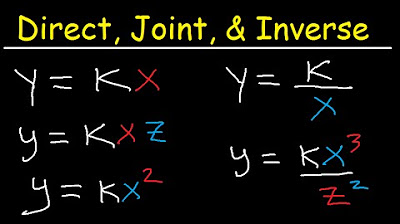CV and EV
Summary
TLDRThis video explains the concepts of compensating variation (CV) and equivalent variation (EV), which assess changes in consumer welfare due to price changes. It outlines two methods of compensating a consumer for price shifts: compensating variation (compensating after the price change) and equivalent variation (compensating before the price change). The script also highlights the conditions under which these methods yield the same result, specifically when preferences are quasi-linear. The discussion emphasizes how these tools help evaluate welfare differences by comparing utility functions, with a focus on their application in welfare economics.
Takeaways
- 😀 Indifference curves represent combinations of goods that give the same utility to a consumer.
- 😀 A consumer maximizes utility by choosing the bundle where their indifference curve is tangent to their budget constraint.
- 😀 The budget constraint reflects all combinations of goods a consumer can afford, with its slope determined by the ratio of prices (p1/p2).
- 😀 When a price changes, the budget constraint shifts, affecting the consumer's ability to reach the original utility level.
- 😀 If the price of a good increases, the consumer faces a lower utility level, requiring a new utility-maximizing bundle.
- 😀 Compensating variation is the amount of money needed to give the consumer after the price change to achieve their original utility level.
- 😀 Equivalent variation is the amount of money that can be taken from the consumer before the price change to maintain the same utility level as after the price change.
- 😀 Compensating variation compensates after the price change, while equivalent variation compensates before the price change.
- 😀 In most cases, compensating variation is slightly larger than consumer surplus, which is larger than equivalent variation.
- 😀 When a consumer has quasi-linear preferences, compensating variation, consumer surplus, and equivalent variation are equal.
Q & A
What is the main purpose of using indifference curves in consumer theory?
-Indifference curves are used to represent all combinations of two goods that give the consumer the same level of satisfaction. The consumer chooses the bundle where the budget constraint is tangent to the highest indifference curve, maximizing utility.
How does a price change affect the consumer's utility and budget constraint?
-When the price of a good changes, the consumer's budget constraint shifts. If the price increases, the budget set becomes smaller, and the consumer can no longer afford the same utility level. As a result, the consumer needs to make a new utility choice.
What is the difference between compensating variation and equivalent variation?
-Compensating variation is the amount of money needed to compensate the consumer after a price change so they can reach the same utility level as before. Equivalent variation, on the other hand, calculates how much money you could take away from the consumer at old prices to maintain the same utility level as the post-price-change utility.
How is compensating variation calculated after a price change?
-To calculate compensating variation, you adjust the consumer's income after the price change and shift the budget constraint so that it is tangent to the original indifference curve. This amount of money is the compensation required to restore the consumer’s original utility.
What does equivalent variation aim to achieve?
-Equivalent variation seeks to find the amount of money that could be taken away from the consumer at the old prices, while ensuring that their utility level remains the same as it would be after the price change. This compensates the consumer before the price change occurs.
What is the key difference between compensating and equivalent variation in terms of timing?
-The key difference is the timing of the compensation: compensating variation is calculated after the price change, while equivalent variation is calculated before the price change.
When are compensating variation and equivalent variation equal?
-Compensating variation and equivalent variation are equal in the case of quasi-linear preferences, where the utility function shifts in a parallel fashion. In this case, both variations result in the same compensation amount.
Why is compensating variation usually larger than equivalent variation?
-Compensating variation is usually larger than equivalent variation because it accounts for the consumer's utility loss after the price change, and the compensation required to restore the original utility tends to be higher than the amount required before the price change.
How does the consumer surplus relate to compensating and equivalent variation?
-In the case of quasi-linear preferences, compensating variation is equal to the consumer surplus and equivalent variation. In other cases, the consumer surplus will be slightly smaller than compensating variation and larger than equivalent variation.
Why are compensating variation and equivalent variation important in economics?
-These concepts are important because they help measure the welfare effects of price changes on consumers. By calculating the amount of compensation needed to restore utility, economists can assess how price changes impact consumer welfare and make policy recommendations.
Outlines

This section is available to paid users only. Please upgrade to access this part.
Upgrade NowMindmap

This section is available to paid users only. Please upgrade to access this part.
Upgrade NowKeywords

This section is available to paid users only. Please upgrade to access this part.
Upgrade NowHighlights

This section is available to paid users only. Please upgrade to access this part.
Upgrade NowTranscripts

This section is available to paid users only. Please upgrade to access this part.
Upgrade NowBrowse More Related Video

Direct Inverse and Joint Variation Word Problems

Supply and demand

GENERAL BIOLOGY 2, MECHANISMS THAT PRODUCE CHANGE IN POPULATIONS

Sources of genetic variation | Inheritance and variation | High school biology | Khan Academy

Episode 12: Change in Demand vs Change in Quantity Demanded

(OLD VERSION) The Demand Curve Shifts
5.0 / 5 (0 votes)